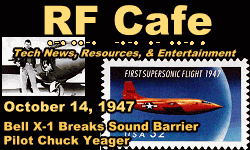|
 October 14 October 14
 Today is
World
Standards Day for technology. 1884: Transparent paper-strip
photographic film was patented by George Eastman. 1908:
George Brown, who developed the turnstile TV antenna, and the
vestigial sideband filter, was born. 1923: Xilinx co-founder
Bernard Vonderschmitt was born. 1927:
Oil
was discovered at Kirkuk in Iraq. 1947: Chuck Yeager became the first man to
fly faster than the speed of sound in the rocket powered
Bell X-1 over
Murac Dry Lake, CA. 1960: The 4th legal definition of the meter was made to be 1,650,763.73
wavelengths in vacuum of the orange-red light radiation of the krypton-86 atom (transition
between levels 2p10 and 5d5). 1984:
Sir Martin Ryle,
who developed the first synthetic aperture radio telescope systems, died. 1996:
The Dow Jones Industrial Average (DJIA) closed above 6,000 for the first time. 1997: British Royal
Air Force pilot Andy Green broke the land-speed record by driving a jet-powered
car faster than the speed of sound. 2001: NASA's Galileo spacecraft passed within
112 miles of Jupiter's moon Io. 2004: The FCC adopted rules for broadband over power
lines (BPL). 2010:
Benoit Mandelbrot,
popularize of fractal geometry, died. Today is
World
Standards Day for technology. 1884: Transparent paper-strip
photographic film was patented by George Eastman. 1908:
George Brown, who developed the turnstile TV antenna, and the
vestigial sideband filter, was born. 1923: Xilinx co-founder
Bernard Vonderschmitt was born. 1927:
Oil
was discovered at Kirkuk in Iraq. 1947: Chuck Yeager became the first man to
fly faster than the speed of sound in the rocket powered
Bell X-1 over
Murac Dry Lake, CA. 1960: The 4th legal definition of the meter was made to be 1,650,763.73
wavelengths in vacuum of the orange-red light radiation of the krypton-86 atom (transition
between levels 2p10 and 5d5). 1984:
Sir Martin Ryle,
who developed the first synthetic aperture radio telescope systems, died. 1996:
The Dow Jones Industrial Average (DJIA) closed above 6,000 for the first time. 1997: British Royal
Air Force pilot Andy Green broke the land-speed record by driving a jet-powered
car faster than the speed of sound. 2001: NASA's Galileo spacecraft passed within
112 miles of Jupiter's moon Io. 2004: The FCC adopted rules for broadband over power
lines (BPL). 2010:
Benoit Mandelbrot,
popularize of fractal geometry, died.
| Jan
| Feb | Mar |
Apr | May |
Jun | Jul |
Aug | Sep |
Oct | Nov |
Dec |
Note: These
historical tidbits have been collected from various sources, mostly on the Internet.
As detailed in
this article, there
is a lot of wrong information that is repeated hundreds of times because most websites
do not validate with authoritative sources. On RF Cafe, events with
hyperlinks have been verified. Many years ago,
I began commemorating the birthdays of notable people and events with
special RF Cafe logos.
Where available, I like to use images from postage stamps from the country where
the person or event occurred. Images used in the logos are often from open source
websites like Wikipedia, and are specifically credited with a hyperlink back to
the source where possible.
Fair Use laws permit
small samples of copyrighted content.
|








 October 14
October 14
